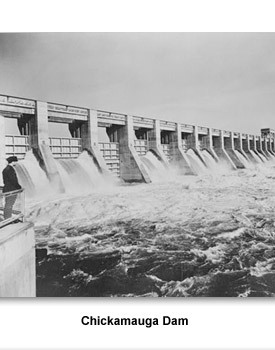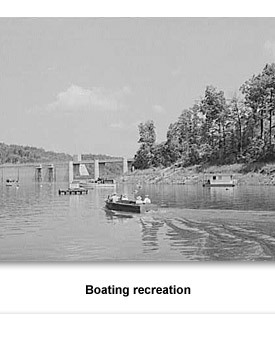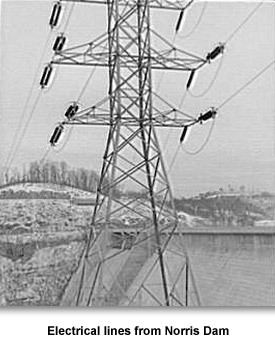The Great Depression & WW II
Lasting Changes
One of the most significant and lasting ways that people contributed to their communities and state during the Great Depression was by participating in new federal work relief programs.
In trying to make work for unemployed people, these programs provided the resources needed to make enduring contributions to preserving both the state’s natural beauty and cultural heritage.
Through these programs, Tennesseans improved the life of their communities for years to come. In addition to buildings, workers created and improved state and national parks in Tennessee.
The Tennessee Valley Authority brought not only cheap electric power but a new system of lakes and recreational parks for all to enjoy.
Electricity brought great improvements to people’s lives. There were the obvious advantages of electric lights, heat, and cooking stoves. But without an electric pump, people had to haul water into their houses from a well and then heat it for bathing and cleaning. A Tennessee farmer said that after his religious faith, “the next greatest thing is to have electricity.”
Social Security became a benefit that Americans depended on. It offered the security of having a monthly income after retirement or when a parent died leaving young children.
Electricity brought great improvements to people’s lives. There were the obvious advantages of electric lights, heat, and cooking stoves. But without an electric pump, people had to haul water into their houses from a well and then heat it for bathing and cleaning. A Tennessee farmer said that after his religious faith, “the next greatest thing is to have electricity.”
Social Security became a benefit that Americans depended on. It offered the security of having a monthly income after retirement or when a parent died leaving young children.
Sometimes difficulties help draw communities closer together. Even in the midst of hard times, the Tennessee tradition of helping your neighbor continued.
Picture Credits:
- Electrical lines from Norris Dam carry electrical power to the nearby countryside in this 1942 photograph by Arthur Rothstein. Library of Congress
- Social Security poster published during the Great Depression. The Social Security program not only offered payments to retirees, it also paid a monthly benefit to parents left with young children after the other parent died. Franklin D. Roosevelt Presidential Library
- The Rural Electrification project brought electricity to rural homes across Tennessee. In this photograph, a Mrs. Wiegel, identified as a farm wife, enjoys her new electric kitchen. Photographed by Arthur Rothstein for the Farm Security Administration in 1942. Library of Congress
- A photograph of boaters on Norris Lake in 1942. The new series of dams constructed in Tennessee to provide electricity and flood control had the added benefit of providing lakes for boating recreation. Photographed by Arthur Rothstein. Library of Congress
- Photograph of Chickamauga Dam and powerhouse, shortly after it was completed in 1940. The flood gates are open in this photograph sending water down the spillways. The dam was built by the Tennessee Valley Authority. Library of Congress
The Great Depression & WW II >> The Great Depression >> Lasting Changes >>





 Sponsored by: National Endowment for the Humanities
Sponsored by: National Endowment for the Humanities